Optimal Lane Allocation Strategy in Toll Stations for Mixed Human-Driven and Autonomous Vehicles
Abstract
:1. Introduction
1.1. Literature Review
1.2. Contributions and Paper Outline
2. Problem Statement, Notations, and Assumptions
2.1. Study Area
2.2. Toll Station Queuing System
2.3. Heterogeneous Traffic Flow
3. Methodology
3.1. Optimization Model
3.1.1. Highway Toll Station Lane Allocation
3.1.2. Multi-Class User Equilibrium
3.2. Single-Level Programming Model for the TSLAP
4. Numerical Experiments
4.1. Computational Performance
4.2. The Impact of Vehicle Composition and Arrival Rate
4.3. Discussion
4.3.1. The Proposed Model Enhances Toll Station Performance with Computational Efficiency
4.3.2. MTC-HVs Proportion: The Most Critical Factor Among Vehicle Types
4.3.3. Dynamically Adjusting Lane Allocation Exhibits Significant Potential
5. Conclusions and Future Research
Author Contributions
Funding
Institutional Review Board Statement
Informed Consent Statement
Data Availability Statement
Conflicts of Interest
Abbreviations
| TSLAP | Toll station lane allocation problem |
| MINLBP | Mixed-integer nonlinear bilevel programming |
| ETC | Electronic toll collection |
| MTC | Manual toll collection |
| CAVs | Connected Autonomous Vehicles |
| TTS | Toll station system |
| KKT | Karush–Kuhn–Tucker |
Appendix A. Necessary Condition for the Existence of Feasible Solutions
Appendix B. The Relaxed Solution of the TSLAP
Appendix B.1. Relaxed Solution of the Upper-Level Problem
Appendix B.2. Solving Relaxed Bilevel Programming Problems Using Iterative Methods
Appendix C. Optimal Solutions Under Varying Vehicle Compositions and Arrival Rate


References
- Ahmed, A.H.; Fragonara, L.Z. Adaptive intelligent traffic control systems for improving traffic quality and congestion in smart cities. Int. J. Qual. Res. 2021, 15, 139–154. [Google Scholar] [CrossRef]
- Bansal, P.; Graham, D.J. Congestion in cities: Can road capacity expansions provide a solution? Transp. Res. Part A Policy Pract. 2023, 174, 103726. [Google Scholar]
- Ren, Q.; He, J.; Liu, Z.; Xu, M. Traffic flow characteristics and traffic conflict analysis in the downstream area of expressway toll station based on vehicle trajectory data. Asian Transp. Stud. 2024, 10, 100138. [Google Scholar] [CrossRef]
- Yang, X.; Zou, Y.; Tang, J.; Liang, J.; Ijaz, M. Evaluation of short-term freeway speed prediction based on periodic analysis using statistical models and machine learning models. J. Adv. Transp. 2020, 2020, 9628957. [Google Scholar] [CrossRef]
- Smith, M.; Huang, W.; Viti, F.; Tampère, C.M.; Lo, H.K. Quasi-dynamic traffic assignment with spatial queueing, control and blocking back. Transp. Res. Part B Methodol. 2019, 122, 140–166. [Google Scholar] [CrossRef]
- He, H.-D.; Lu, D.-N.; Zhao, H.-M.; Peng, Z.-R. Characterizing CO2 and NOx emission of vehicles crossing toll stations in highway. Transp. Res. Part D Transp. Environ. 2024, 126, 104024. [Google Scholar] [CrossRef]
- Bao, Y.; Xiao, F.; Gao, Z.; Gao, Z. Investigation of the traffic congestion during public holiday and the impact of the toll-exemption policy. Transp. Res. Part B Methodol. 2017, 104, 58–81. [Google Scholar] [CrossRef]
- Liu, C.; Tao, S.; Zhao, C.; Ji, Y.; Du, Y. Optimal deployment of electronic toll collection lanes for freeway network. China J. Highw. Transp. 2022, 35, 179–188. [Google Scholar]
- Anderson, M.L.; Davis, L.W. An empirical test of hypercongestion in highway bottlenecks. J. Public Econ. 2020, 187, 104197. [Google Scholar] [CrossRef]
- Deepashree, R.; Radhika, K.N. Ways to Avoid Traffic Congestion in India and make India Smarter—A Prelude. Int. J. Eng. Res. Technol. 2020, 8, 209–213. [Google Scholar]
- Tseng, P.; Pilcher, N. Political and technical complexities of electronic toll collection: Lessons from Taiwan. Case Stud. Transp. Policy 2022, 10, 444–453. [Google Scholar] [CrossRef]
- Marina, M.; Nikolić, M.; Glavić, D. Optimization of toll road lane operation: Serbian case study. Oper. Res. 2022, 22, 5297–5322. [Google Scholar]
- Petrović, A.; Nikolić, M.; Bugarić, U.; Delibašić, B.; Lio, P. Controlling highway toll stations using deep learning, queuing theory, and differential evolution. Eng. Appl. Artif. Intell. 2023, 119, 105683. [Google Scholar] [CrossRef]
- Zhang, H.; Cheng, C.; Zhang, C.; He, J.; Xu, Y.; Chen, Y.; Hong, Q. Optimization of Opening Scheme of ETC/MTC Toll Lane Based on Cost and Benefit Analysis. IOP Conf. Ser. Earth Environ. Sci. 2021, 638, 012032. [Google Scholar] [CrossRef]
- Elassy, M.; Al-Hattab, M.; Takruri, M.; Badawi, S. Intelligent transportation systems for sustainable smart cities. Transp. Eng. 2024, 16, 100252. [Google Scholar] [CrossRef]
- Ngoduy, D.; Nguyen, C.H.P.; Lee, S.; Zheng, Z.; Lo, H.K. A dynamic system optimal dedicated lane design for connected and autonomous vehicles in a heterogeneous urban transport network. Transp. Res. Part E Logist. Transp. Rev. 2024, 186, 103562. [Google Scholar] [CrossRef]
- Di, Y.; Zhang, W.; Ding, H.; Zheng, X.; Ran, B. Cooperative control of dynamic CAV dedicated lanes and vehicle active lane changing in expressway bottleneck areas. Phys. A Stat. Mech. Its Appl. 2024, 638, 129623. [Google Scholar] [CrossRef]
- Almukhalfi, H.; Noor, A.; Noor, T.H. Traffic management approaches using machine learning and deep learning techniques: A survey. Eng. Appl. Artif. Intell. 2024, 133, 108147. [Google Scholar] [CrossRef]
- Saad, M.; Abdel-Aty, M.; Lee, J. Analysis of driving behavior at expressway toll plazas. Transp. Res. Part F Traffic Psychol. Behav. 2019, 61, 163–177. [Google Scholar] [CrossRef]
- Xiang, W.; Wang, C.; Li, X.; Xue, Q.; Liu, X. Optimizing guidance signage system to improve drivers’ lane-changing behavior at the expressway toll plaza. Transp. Res. Part F Traffic Psychol. Behav. 2022, 90, 382–396. [Google Scholar] [CrossRef]
- Subraveti, H.H.S.N.; Srivastava, A.; Ahn, S.; Knoop, V.L.; van Arem, B. On lane assignment of connected automated vehicles: Strategies to improve traffic flow at diverge and weave bottlenecks. Transp. Res. Part C Emerg. Technol. 2021, 127, 103126. [Google Scholar] [CrossRef]
- Wang, P.; Zhao, J.; Gao, Y.; Sotelo, M.A.; Li, Z. Lane Work-Schedule of Toll Station Based on Queuing Theory and PSO-LSTM Model. IEEE Access 2020, 8, 84434–84443. [Google Scholar] [CrossRef]
- Abdelwahab, H.T. Traffic micro-simulation model for design and operational analysis of barrier toll stations. Ain Shams Eng. J. 2017, 8, 507–513. [Google Scholar] [CrossRef]
- Sewagegn, A. Optimization of toll services using queuing theory in the case of ethiopia. Perner’s Contacts 2022, 17, 2. [Google Scholar] [CrossRef]
- Qiu, M.; Li, D.; Zhou, D. Determination Optimal Indicators of Expressway Toll Plaza with M/G/1 Queue Model. Int. J. Appl. Phys. Math. 2020, 10, 96–111. [Google Scholar] [CrossRef]
- Zhu, D.; Dong, F.; Shi, W.; Zheng, S. The Model of Toll Station Planing. In Proceedings of the 2017 2nd International Conference on Control, Automation and Artificial Intelligence (CAAI2017), Sanya, China, 25–26 June 2017; Volume 134, pp. 390–394. [Google Scholar]
- Yuan, N.; Ma, M.; Liang, S.; Wang, W.; Zhang, H. Optimal control method of freeway based on tollbooths lane configuration and variable speed limit control. Phys. A Stat. Mech. Its Appl. 2022, 603, 127801. [Google Scholar] [CrossRef]
- Ramchandra, N.R.; Rajabhushanam, C. Machine learning algorithms performance evaluation in traffic flow prediction. Mater. Today Proc. 2022, 51, 1046–1050. [Google Scholar] [CrossRef]
- Chen, L.-W.; Chen, D.-E. Exploring spatiotemporal mobilities of highway traffic flows for precise travel time estimation and prediction based on electronic toll collection data. Veh. Commun. 2021, 30, 100356. [Google Scholar] [CrossRef]
- CJJ 37-2012; Code for Design of Urban Road Engineering. Ministry of Housing and Urban-Rural Development of the People’s Republic of China: Beijing, China, 2016.

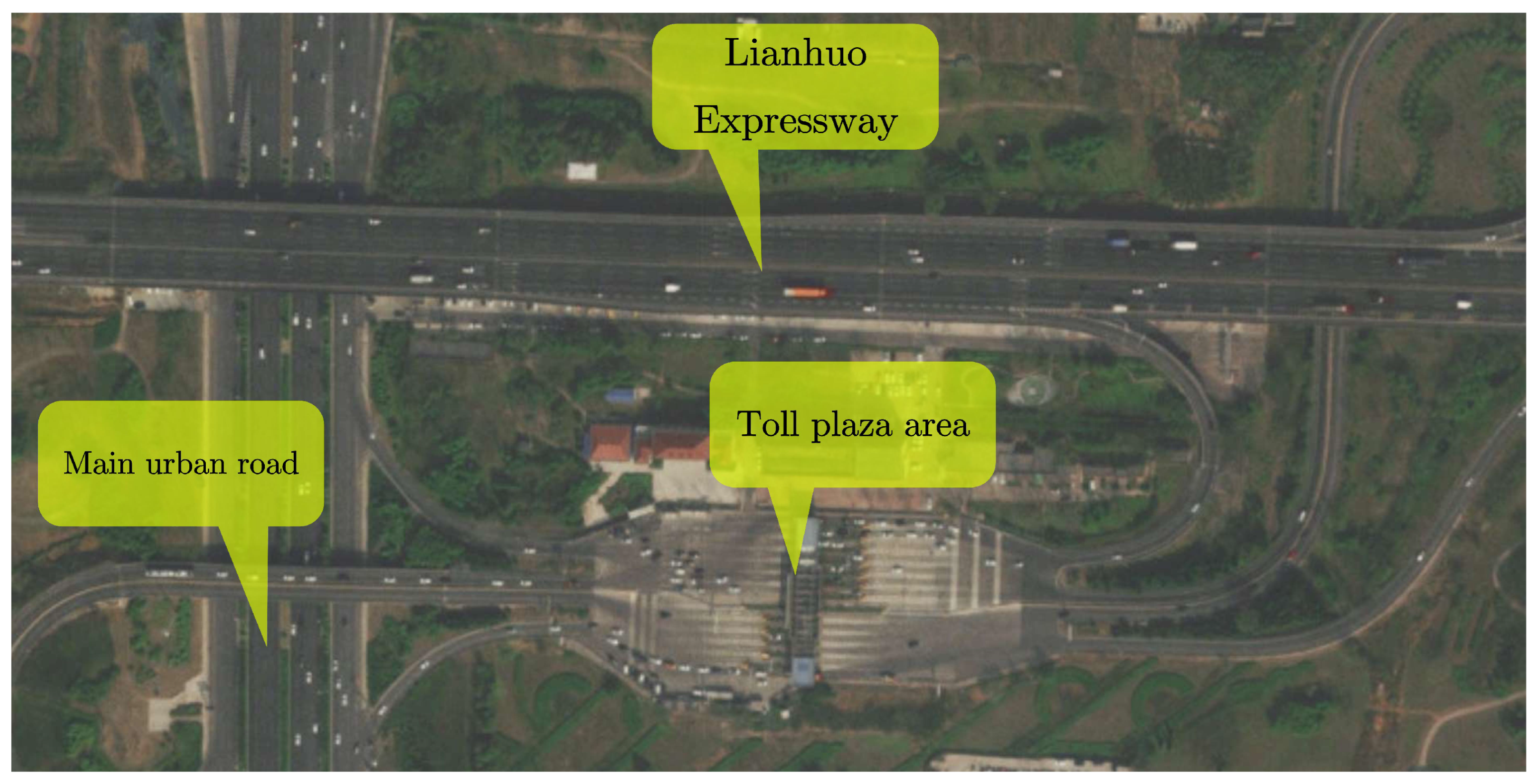
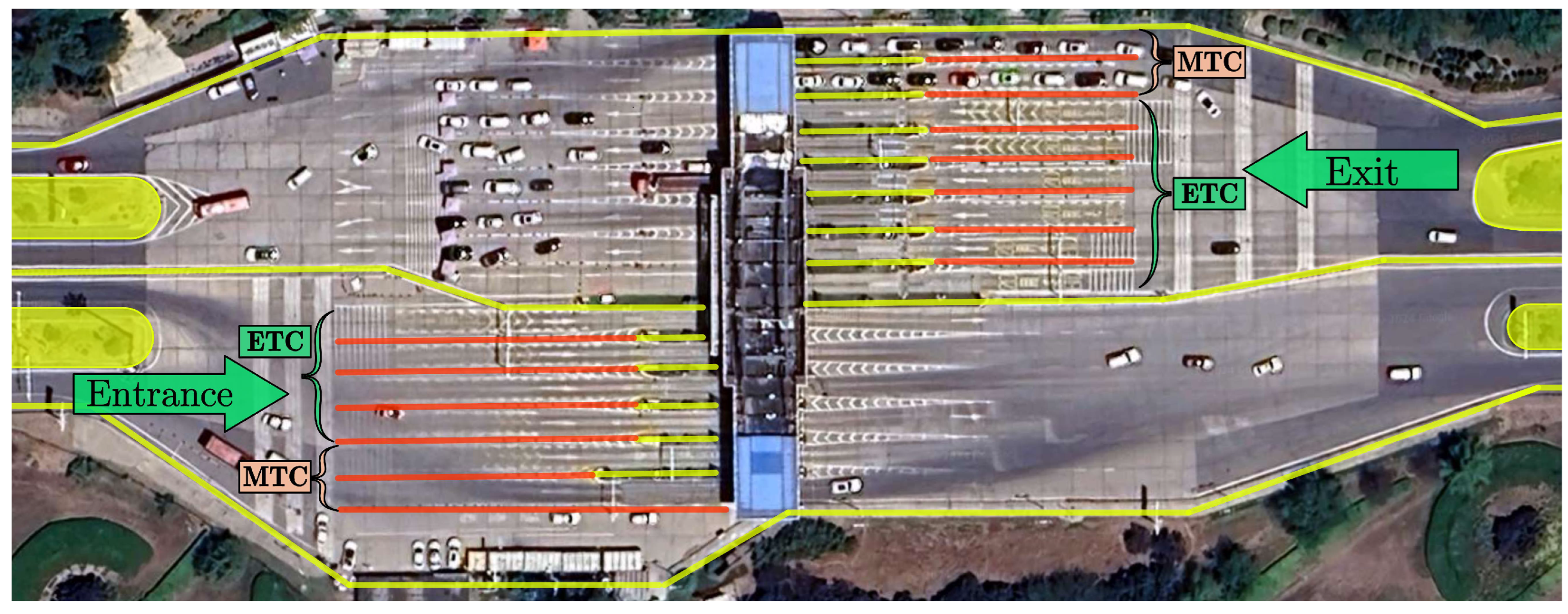

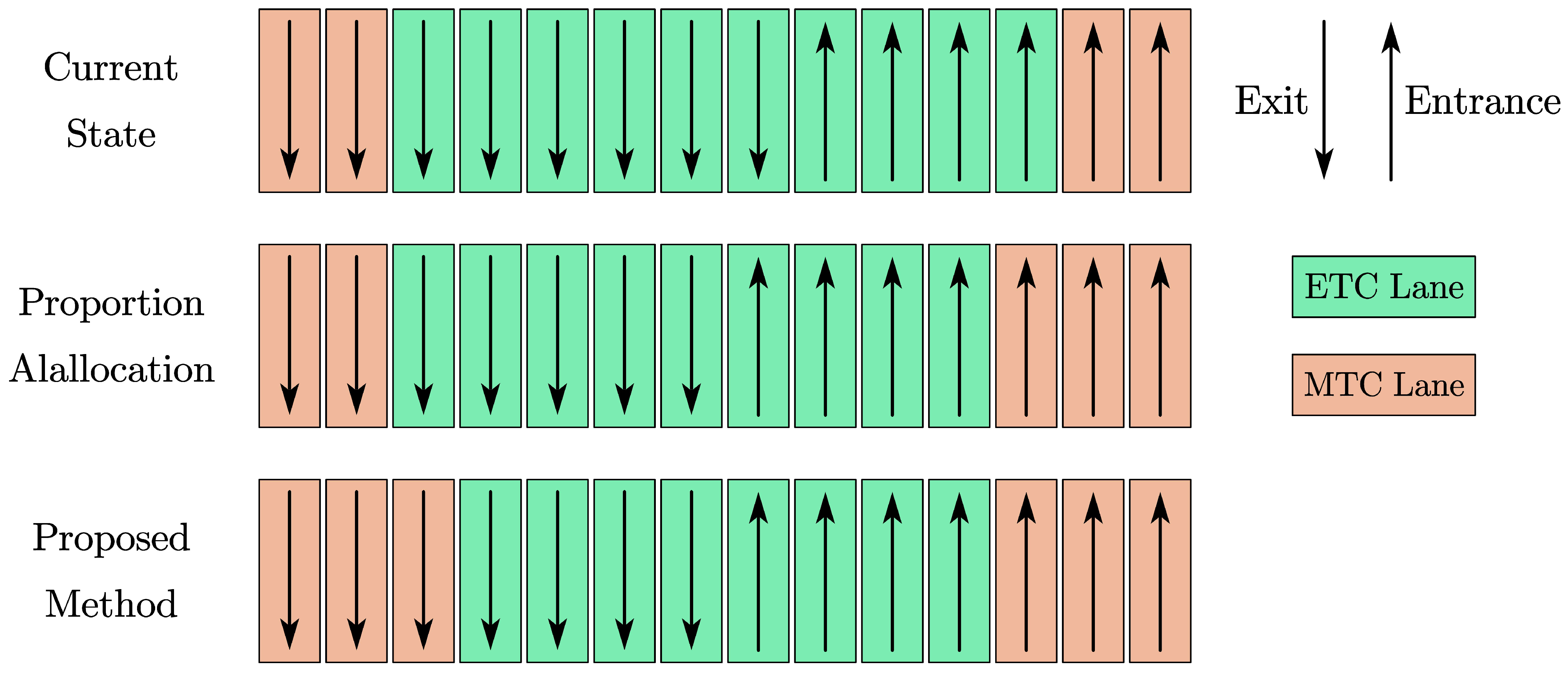
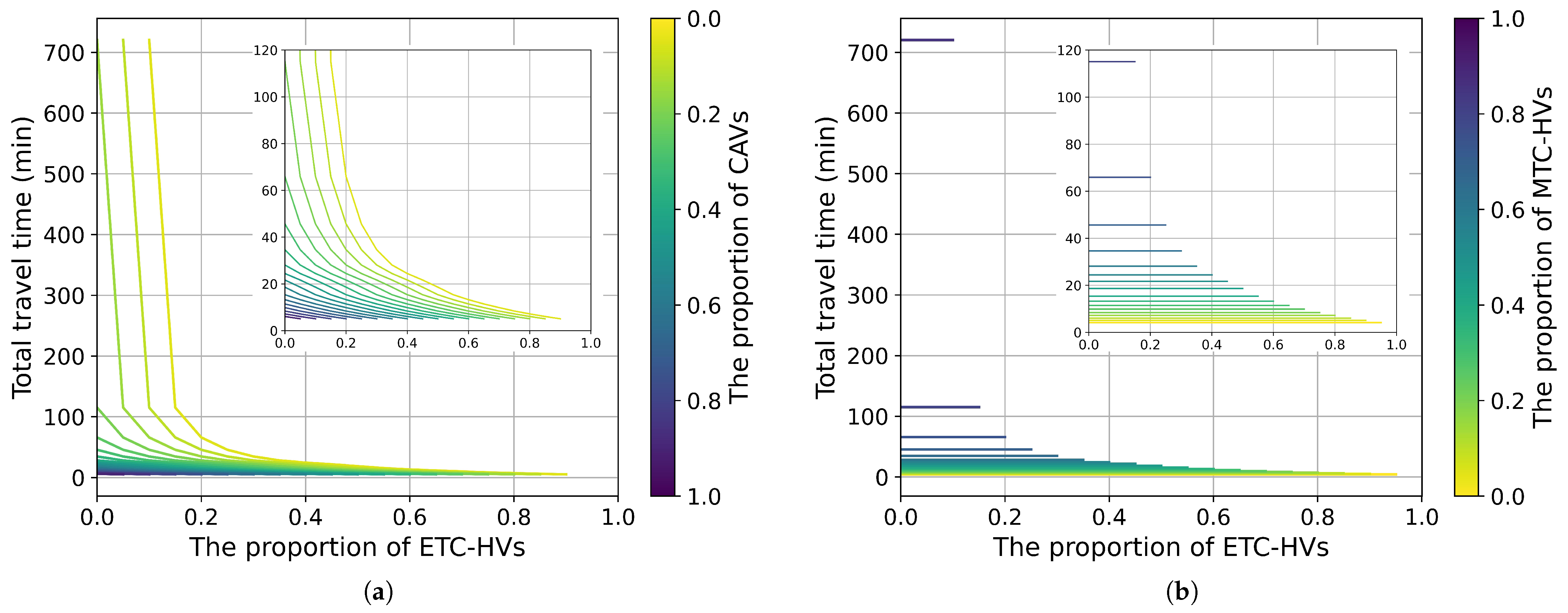
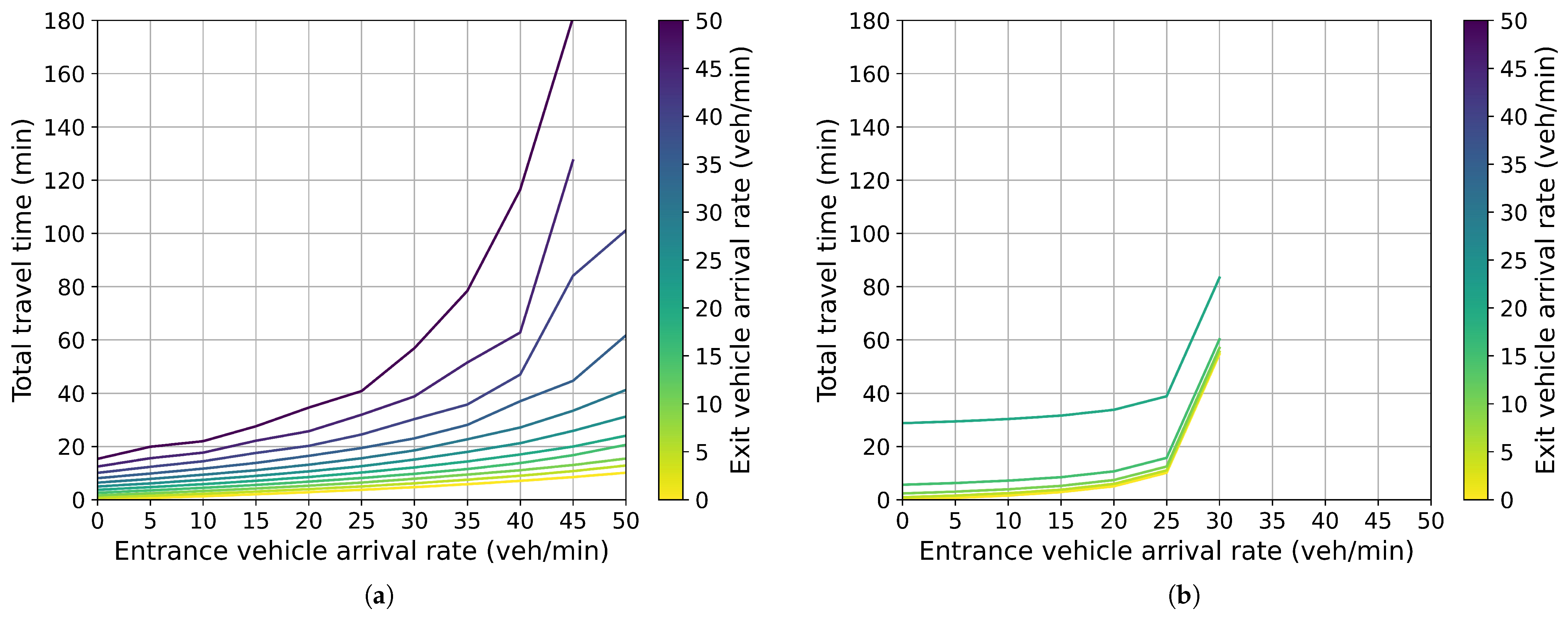
| Paper | Country | Sample | Methods | Key Findings |
|---|---|---|---|---|
| [19] | United States | driving simulator | driving simulator | Dynamic message signs and arrow pavement markings reduce lane changes. |
| [20] | China | driving simulator | driving simulator | Toll station guidance signs can improve drivers’ lane change behavior. |
| [13] | Serbia | E70 | , RNNs | RNNs accurately predicted vehicle arrival rates, enhancing model robustness. |
| [8] | China | Shanghai ring expressway | , active set | The proposed method reduces queue time by up to 57.4% compared to proportional allocation. |
| [14] | China | Nanjing toll station | , enumeration | The benefit decreases initially, then rises with increasing ETC vehicle ratio. |
| [23] | Egypt | simulation | , simulation | MTC is inefficient and can cause significant delays to highway traffic. |
| [24] | Ethiopia | Addis-Adama expressway | , simulation | Toll service performance depends on the number of servers, service time, and interarrival time. |
| [25] | United States | New Jerseys expressway | , fluid mechanics | The vehicle security distance impacts toll booth traffic capacity. |
| [22] | China | Dongshe toll station | , PSO-LSTM | The lane scheduling model saves 147,825 RMB annually at Dongshe toll station |
| Indices and Sets | |
|---|---|
| Set of lane directions | |
| Set of toll collection methods | |
| Set of vehicle categories | |
| d | Direction: 1 for entrance, 2 for exit |
| i | Lane type: 1 for ETC lane, 2 for MTC lane |
| j | Vehicle type: 1 for CAVs, 2 for MTC-HVs, and 3 for ETC-HVs |
| c | Indicates that the decision variable is relaxed |
| ∗ | Indicates that variables are treated as parameters |
| Parameters | |
| The service rate of a single lane of type i in direction d | |
| The total number of lanes at the highway toll station | |
| The proportion of vehicle type j in direction d | |
| The proportion of ETC-HVs choosing the lanes of type i in direction d | |
| The arrival rate of vehicles in direction d | |
| The average passage time of vehicles in lane type i in direction d | |
| k | Lagrange multiplier |
| Decision variables | |
| The number of lanes of type i in direction d | |
| The vehicle arrival rate for lane type i in direction d |
| Lane Allocation and System Performance | Current State | Proportional Allocation | Proposed Method | |||
|---|---|---|---|---|---|---|
| Entry | Exit | Entry | Exit | Entry | Exit | |
| Number of ETC lanes (lanes) | 4 | 6 | 5 | 5 | 3 | 3 |
| Number of MTC lanes (lanes) | 2 | 2 | 2 | 2 | 4 | 4 |
| Traffic intensity of ETC lanes | 0.31 | 0.19 | 0.25 | 0.22 | 0.42 | 0.37 |
| Traffic intensity of MTC lanes | 0.76 | 0.98 | 0.76 | 0.98 | 0.38 | 0.49 |
| Total travel time (minutes) | 106.95 | 106.87 | 10.22 | |||
Disclaimer/Publisher’s Note: The statements, opinions and data contained in all publications are solely those of the individual author(s) and contributor(s) and not of MDPI and/or the editor(s). MDPI and/or the editor(s) disclaim responsibility for any injury to people or property resulting from any ideas, methods, instructions or products referred to in the content. |
© 2025 by the authors. Licensee MDPI, Basel, Switzerland. This article is an open access article distributed under the terms and conditions of the Creative Commons Attribution (CC BY) license (https://creativecommons.org/licenses/by/4.0/).
Share and Cite
Chai, Z.; Ran, T.; Xu, M. Optimal Lane Allocation Strategy in Toll Stations for Mixed Human-Driven and Autonomous Vehicles. Appl. Sci. 2025, 15, 364. https://doi.org/10.3390/app15010364
Chai Z, Ran T, Xu M. Optimal Lane Allocation Strategy in Toll Stations for Mixed Human-Driven and Autonomous Vehicles. Applied Sciences. 2025; 15(1):364. https://doi.org/10.3390/app15010364
Chicago/Turabian StyleChai, Zuoyu, Tanghong Ran, and Min Xu. 2025. "Optimal Lane Allocation Strategy in Toll Stations for Mixed Human-Driven and Autonomous Vehicles" Applied Sciences 15, no. 1: 364. https://doi.org/10.3390/app15010364
APA StyleChai, Z., Ran, T., & Xu, M. (2025). Optimal Lane Allocation Strategy in Toll Stations for Mixed Human-Driven and Autonomous Vehicles. Applied Sciences, 15(1), 364. https://doi.org/10.3390/app15010364






